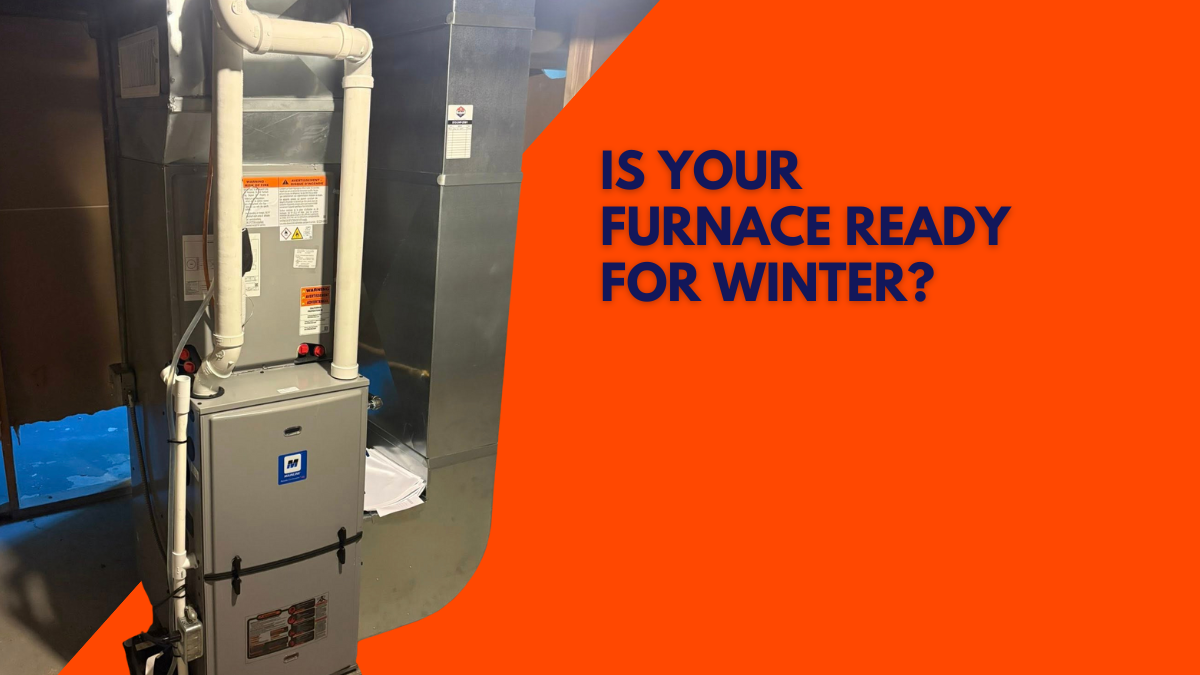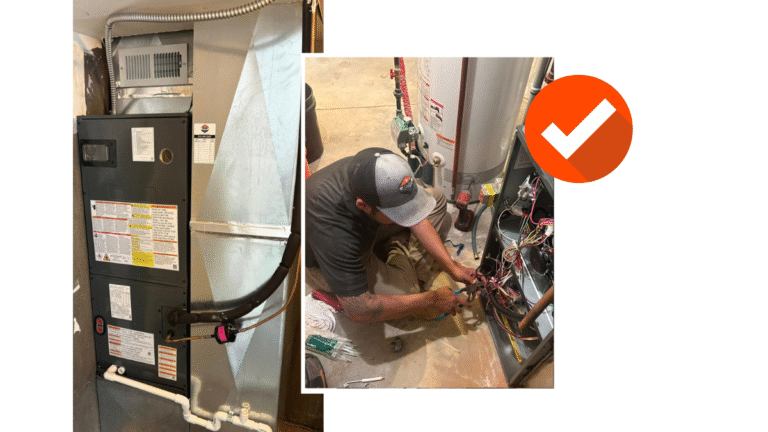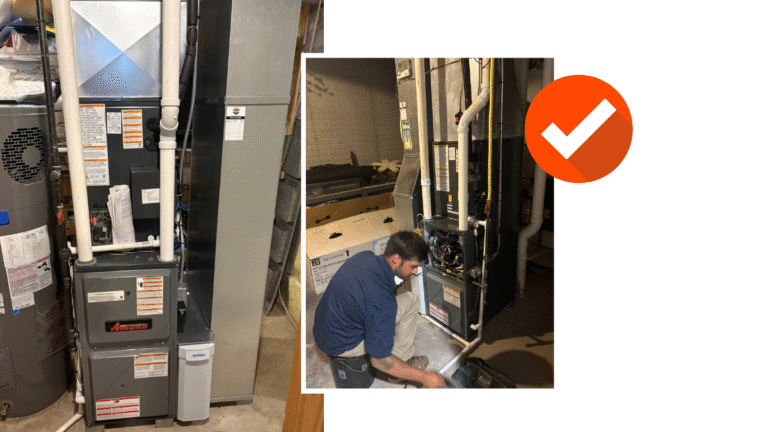
- October 9, 2025
- admin
- 0
Iowa winters do not warm up to anyone. Cold snaps come fast. Wind hurts. Pipes can freeze.
If your furnace quits, the house can drop from cozy to cold in one night.
The good news? Getting ready is simple. You can do most of it in a short afternoon.
This guide gives you a step-by-step furnace checklist, safe start tips, smart thermostat settings, and clear signs it is time to call a pro. We also show you when a fix is not enough and a new heating installation makes sense. Use this before the first hard freeze, and you will be set for the season.
Need help at any step? Book a fall tune-up with Anthem: Contact us. Want year-round care? Ask about our maintenance plans when you call.
The Fast Test: How to Know If Your Furnace Is Ready
Do a quick scan before you dig into the deep list. You only need ten minutes.
Set the thermostat to Heat. Raise the setpoint by 3–5 degrees.
Listen. You should hear the furnace start. A fan may run first. Warm air should blow in 60–90 seconds.
Feel. Check a few supply vents on each level. Air should feel warm. Flow should feel steady.
Watch the cycle. The furnace should run until the setpoint is met. It should not turn on and off every minute.
Check the display. If your thermostat uses batteries, replace them now. Keep spares in a drawer.
If any part fails—no heat, weak flow, short cycling—do the full checklist below. If you smell gas or see a flame problem, stop and call a pro right away.
For basic home checks, see the ENERGY STAR heating and cooling maintenance checklist. It matches what we show next.
The Fall Furnace Prep Checklist (Step-by-Step)

This list keeps to safe homeowner tasks. If a step mentions gas, wiring, or removal of panels, save it for a licensed tech. Safety first.
1) Set and Test the Thermostat
Switch to Heat.
Raise the setpoint and let the furnace run for ten minutes.
If the room temp on the screen looks off, check with a simple room thermometer.
If your thermostat uses batteries, put new ones in now.
Think about a programmable or smart stat to save energy. See ENERGY STAR guidance on smart thermostats.
Planning an upgrade soon? See Heating Installation options: learn more.
2) Replace or Clean the Air Filter
Airflow is life for a furnace. A clogged filter makes the blower work too hard and can cause a shutdown.
Replace the filter every 1–3 months in heating season.
Match the size printed on the frame.
Use a MERV rating your system can handle. If in doubt, pick a mid-range MERV and change it on time.
ENERGY STAR reminds homeowners that filter changes support airflow and reduce stress on parts. See the maintenance checklist.
3) Open and Clear All Vents
Walk each room. Make sure supply vents and return grilles are open.
Move furniture, rugs, or boxes that block airflow.
Keep at least 12 inches clear in front of returns.
Vacuum dust from registers and returns.
Closing vents to “push heat” to some rooms can raise pressure and hurt the blower. Keep vents open for a healthy system.
4) Tidy the Furnace Area
Clear storage, paint cans, cardboard, and other items from around the unit.
The furnace should have a clear work area for service.
Look for water near the base (could be a condensate drain issue).
Look for soot at panel seams (could be a combustion issue). If you see soot, call a pro.
5) Check the Flame: Blue Is Best
For natural gas furnaces, a steady blue flame with a small yellow tip is normal. Yellow, lifting, or flickering flames can mean poor combustion and a risk of carbon monoxide (CO). Turn it off and call a tech. A simple picture of flame health is included in Trane’s winter prep guide: Is your furnace ready?
Install and test CO alarms near bedrooms and on each level. Replace units per the maker’s date.
6) Listen for Noises and Watch for Short Cycling
Banging or rattling can mean loose panels or ductwork.
Squealing or grinding can point to a belt or motor problem.
Short cycling—the furnace turns on and off every minute—often means airflow trouble (filter, vents) or a safety lockout. Fix the airflow items first. If it continues, call a pro.
If you are facing a no-heat issue during a cold snap, reach out for emergency help: Anthem Emergency Service.
7) Check the Blower Door and Safety Switch
A door switch keeps the furnace from running with the blower panel off. Make sure the panel is seated and latched. If it is not, the system will not start.
8) Put the Flame Sensor on Your Pro’s List
A dirty flame sensor can make the furnace start and then shut down fast. Cleaning this part is simple for a tech and is part of a tune-up.
Ready to book your tune-up? Contact Anthem. When you call, ask about our maintenance plans.
9) Clear the Condensate Drain (High-Efficiency Furnaces)
If your furnace vents with a plastic pipe, it likely makes condensate. That water must drain.
Check that the drain line slopes and is not kinked. Look for water at the base or rust on the cabinet. If you see any, call a pro to clear the line and check for trouble.
10) Replace the Humidifier Pad (If You Have One)
A whole-home humidifier can raise comfort in winter. Swap the water panel or pad each season to avoid scale buildup. Aim for 30–40% indoor humidity. This can make 68°F feel warmer and help you use a lower setpoint.
11) Confirm Safe Venting and Combustion Air
Your health and safety are always top priority.
Check that the flue or vent pipe is secure and not corroded.
For sealed combustion units, inspect the intake and exhaust outside. Clear away debris, nests, or weeds.
In winter, keep these clear of snow after storms.
12) Test CO and Smoke Alarms
Press the test button. Swap batteries now so you do not forget later. Replace devices that are past the maker’s recommended age. If any alarm sounds during furnace operation, turn the unit off and call for service.
13) Schedule a Professional Tune-Up
A tune-up pays for itself by stopping small problems before they become big ones. A pro will:
Clean burners and the flame sensor
Inspect the heat exchanger
Check gas pressure and combustion
Test safety switches
Check the blower and motor
Verify controls and thermostat operation
ENERGY STAR recommends yearly maintenance for heating equipment to improve safety, reliability, and efficiency. See the official checklist. Trane also highlights key winter readiness steps here: Trane winterization guide.
Book your tune-up with Anthem: Contact us. If you are interested in a new system before peak cold, see Heating Installation options: learn more.
Start-of-Season: Safe Start Steps Before the First Real Cold Night

Homeowners often ask, “What should I do before I turn the heat on?” Here is a safe start sequence that answers that:
Clear the area. Nothing stored on or around the furnace. Panel is closed and latched.
CO alarms ready. Test the alarms. Replace batteries.
Thermostat test. Switch to heat. Raise the setpoint.
Run a trial. Let the system run for 10–15 minutes.
Walk the home. Check a vent on each level. Feel for warm, steady air.
Listen. A soft fan sound is normal. No banging, squeals, or grinding.
Check again after a week. Look at the filter. The first week of heat can pull dust into the system.
If at any point you get no heat, see a yellow flame, or smell gas, turn the system off and call for help: emergency service.
Is 72 Too High for Heat in Winter? Smart Settings for Comfort and Cost
The right temperature is the one that keeps your family safe and comfortable while using the least energy. A simple plan works well in most Iowa homes:
When home and awake: try 68–70°F.
When away or asleep: try 62–66°F.
Use a programmable or smart thermostat to set these times and stick to them. See ENERGY STAR tips on smart thermostats and savings: learn more.
Note: If you have a heat pump (not a gas furnace), ask a pro about the best setback strategy. Large setbacks can trigger backup heat in some setups.
When a Repair Isn’t Enough: Signs You May Need Heating Installation
Sometimes a tune-up cannot save an old or unsafe unit. Replacing before peak winter often means better scheduling and fewer surprises. Clear signs it may be time:
Your furnace is 15–20+ years old and has needed several repairs in the last few seasons.
A tech notes heat exchanger wear, unsafe combustion, or rising CO levels.
Bills keep climbing even after filter changes and tune-ups.
Some rooms are cold in winter and hot in summer, or airflow is weak.
The system is too big or too small for the home.
If you are weighing your options, schedule a no-pressure visit to review sizes, efficiency levels, and rebates. See Heating Installation: get details. Or reach out here: Contact Anthem.
Common Mistakes That Cause Mid-Winter Breakdowns
Avoid these easy traps. They lead to many emergency calls:
Closing too many vents or blocking returns. This raises pressure, strains the blower, and can cause overheating.
Using a high-MERV filter your system cannot handle. Airflow drops. Parts overheat. If you want very fine filtration, ask a pro about upgrades matched to your blower.
Skipping the annual tune-up. Dirt builds up. Safety devices fail. Small issues grow.
Ignoring early warning sounds or short cycling. The sooner you act, the cheaper the fix.
Doing DIY gas or electrical work. It is not worth the risk. Call a licensed tech.
If a breakdown hits and the house is dropping fast, call for help: Anthem Emergency Service.
Quick Troubleshooting: If the Furnace Won’t Start
Try these safe checks before you call:
Thermostat set to Heat and the setpoint raised.
Thermostat batteries replaced.
Furnace breaker is on; if tripped, reset once only.
Blower door latched (safety switch engaged).
Filter replaced.
If the unit starts then stops, it may be a flame sensor or safety lockout. Stop and call a pro.
Still no heat? We are here 24/7: Contact Anthem.
FAQ: How to Know If Your Furnace Is Ready for Winter
How do I make sure my furnace is ready?
Run the quick test at the top. Then complete the fall checklist: filter, vents, safety checks, trial run, and tune-up.
What should I do before turning on the heat?
Clear the area, test CO alarms, set the thermostat to heat, run a 10–15 minute cycle, and check vents for warm air and steady flow.
Is 72 too high for winter?
It depends on comfort. Many families like 68–70°F when home and 62–66°F when away or asleep. Use a programmable or smart stat to set a schedule and save energy.
How do I start a furnace after months of no use?
Confirm a clear work area, test alarms, replace the filter, set the stat to heat, and run a short cycle while you listen and feel for steady heat.
Do I need a tune-up every year?
Yes. Yearly care improves safety and cuts breakdowns. See the ENERGY STAR checklist for what pros handle.
When is heating installation a better choice than repair?
If your unit is old, unsafe, or very inefficient—or if repairs keep stacking up—it is often smarter to replace before peak winter. See Heating Installation: more info.
Local Help in Central Iowa
Anthem Heating & Cooling serves Bondurant, Ankeny, Grinnell, and nearby towns. We know Iowa winters. We stock common parts, and our techs are on call day and night when the weather turns rough.
See our local page: Bondurant Service Area
Explore our coverage: Service Areas
Learn about us: About Anthem
Ready to Winter-Proof Your Furnace?
Do these three things this week and sleep easy when the first freeze hits:
Run the fast readiness test.
Work through the fall furnace checklist.
Schedule a tune-up or a heating installation consult if anything feels off.
Stay warm, stay safe, and get ahead of winter—today.
Contact Anthem Heating & Cooling today at 515-249-2581 (Bondurant) or 641-485-1998 (Grinnell). We proudly serve Bondurant, Grinnell, Ankeny, and across Central Iowa.
References
ENERGY STAR — Heating & Cooling Maintenance Checklist
ENERGY STAR — Smart/Programmable Thermostats
